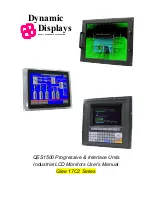
E32.0.02.6C-04
Manual for connection and operation of the
GIA 2000 / AAG and GIR 2002 / AAG
page 28 of 30
13. Specification
Absolute maximum ratings:
see chapter 3.2. (Connection data)
Measuring inputs:
Standard inputs for
Input type
Signal
Range
Resolution
Note
0 – 10 V
0 ... 10 V
Ri > 200 kOhm
0 – 2 V
0 ... 2 V
Ri > 10 kOhm
0 – 1 V
0 ... 1 V
Ri > 10 kOhm
Standard-
voltage-signal
0 – 50 mV
0 ... 50 mV
Ri > 10 kOhm
4 – 20 mA
4 ... 20 mA
Ri = ~ 125 Ohm
Standard-
current-signal
0 – 20 mA
0 ... 20 mA
Ri = ~ 125 Ohm
-50.0 ... +200.0 °C
(-58.0 ... +392.0 °F)
0.1 °C / °F
Pt100
-200 ... +850 °C
(-328 ... +1562 °F)
1 °C / °F
3-wire-connection
max. perm. line resistance: 20 Ohm
RTD probes
Pt1000
-200 ... +850 °C
(-328 ... +1562 °F)
1 °C / °F
2- wire-connection
-70.0 ... +250.0 °C
(-94.0 ... +482.0 °F)
0.1 °C / °F
NiCr-Ni
(Type K)
-270 ... +1372 °C
(-454 ... +2502 °F)
1 °C / °F
Pt10Rh-Pt
(Type S)
-50 ... +1750 °C
(-58 ... +3182 °F)
1 °C / °F
-100.0 ... +300.0 °C
(-148.0 ...+572.0 °F)
0.1 °C / °F
NiCrSi-NiSi
(Type N)
-270 ... +1350 °C
(-454 ... +2462 °F)
1 °C / °F
-70.0 ... +300.0 °C
(-94.0 ...+572.0 °F)
0.1 °C / °F
Fe-CuNi
(Type J)
-170 ... +950 °C
(-274 ... +1742 °F)
1 °C / °F
-70.0 ... +200.0 °C
(-94.0 ... +392.0 °F)
0.1 °C / °F
Thermocouple
probes
Cu-CuNi
(Type T)
-270 ... +400 °C
(-454 ... +752 °F)
1 °C / °F
TTL-Signal
0 Hz ... 10 kHz
0.1 mHz
signal low: 0.0 – 0.5 V
signal high: 2.7 – 24 V
Switching contact
NPN
0 Hz ... 3 kHz
0.1 mHz
An internal pull-up-resistor (~11 kOhm to
+3.3V) is connected automatically.
Frequency
Switching contact
PNP
0 Hz ... 1 kHz
0.1 mHz
An internal pull-down-resistor (~11 kOhm
to GND) is connected automatically.
Rotation
TTL-Signal,
Switching contact NPN,
PNP
0 ... 9999 U/min
0.001 U/min
Pre-scaling-factor (1-1000),
Pulse-frequency: max. 600000 p./min. *
TTL-Signal,
Switching contact NPN,
PNP
0 ... 9999
with pre-scaling factor:
9 999 000
Pre-scaling-factor (1-1000)
Pulse-frequency: max. 10000 p./sec. *
Up/Downwards
- Counter
Counter reset input
--
Reset:
R < 1 kOhm
Enable:
R > 100 kOhm
* = with switching contact accordingly to frequency input lower values may occur



































